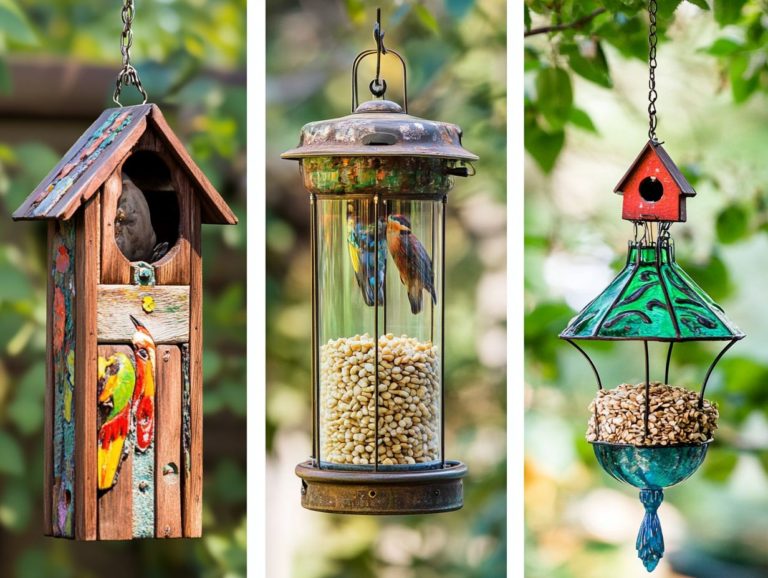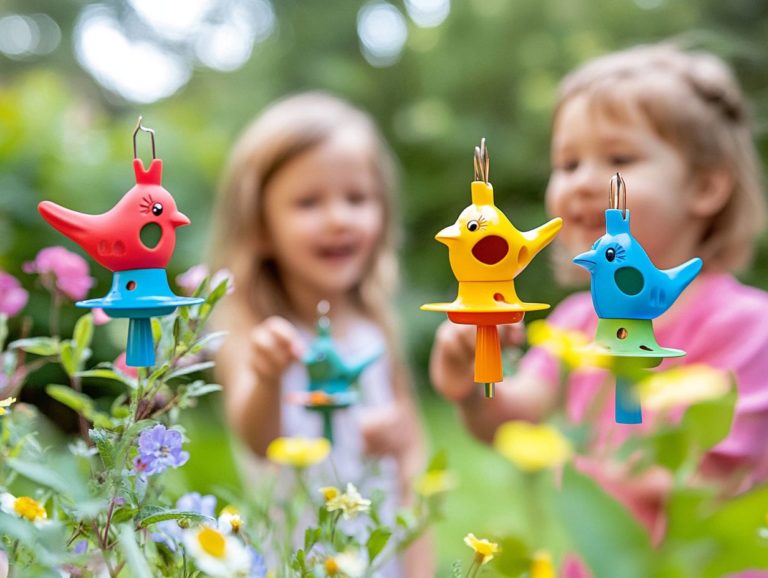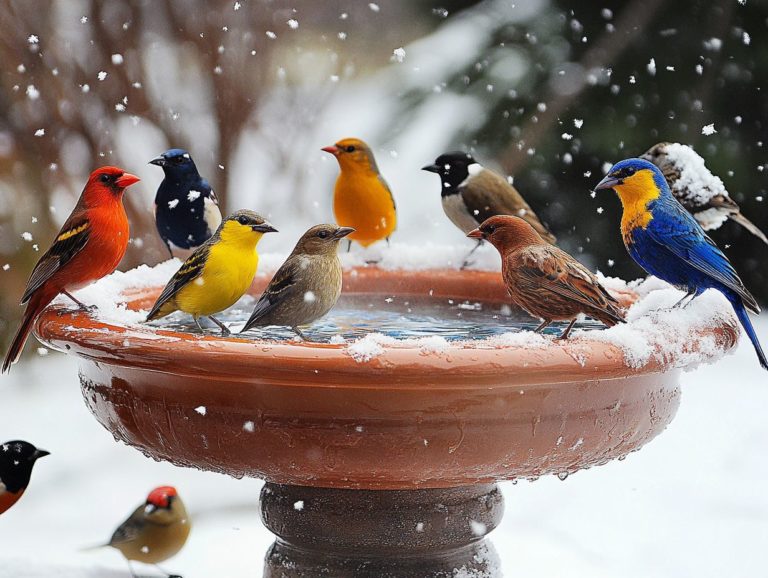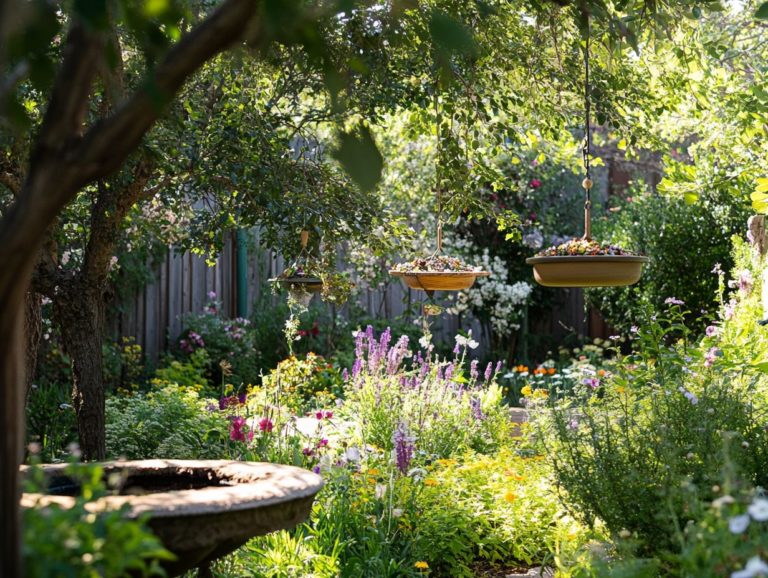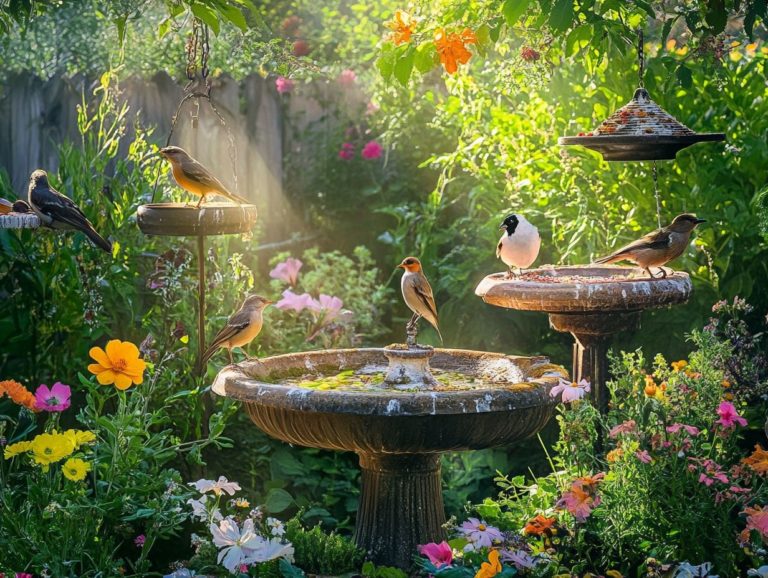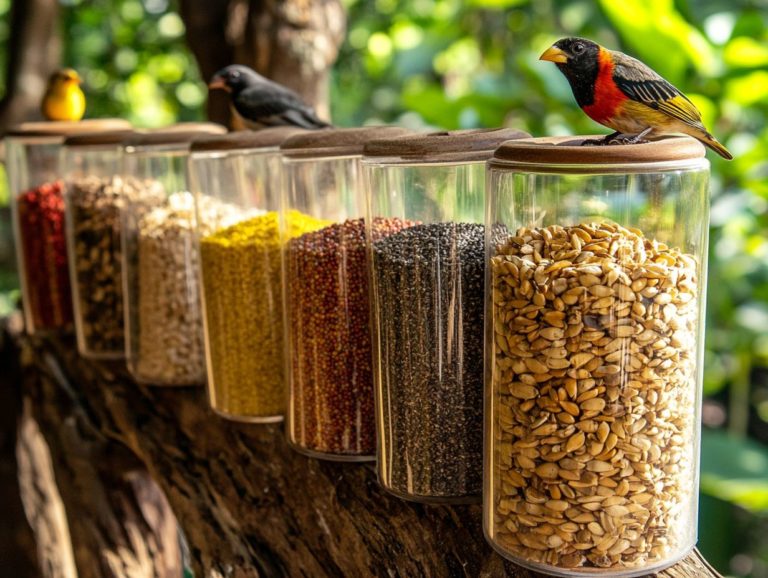5 Most Common Bird Bath Mistakes
Bird baths can transform your outdoor garden into a delightful oasis, attracting birds and enhancing the overall beauty of your outdoor space. However, many enthusiasts unknowingly fall into common traps that can deter these feathered friends or even harm them.
In this exploration, you’ll uncover the five most prevalent bird bath pitfalls, from neglecting regular cleaning to placing them in direct sunlight, where they might become more of a sauna than a sanctuary. You’ll also find valuable birdwatching tips on how to craft a safe and inviting environment for birds, ensuring your bird bath turns into a popular gathering spot.
Discover the best practices for caring for birds and watch your garden come alive with their presence! Learn how to ensure your bird bath is a safe haven for your feathered friends!
Contents
Key Takeaways:
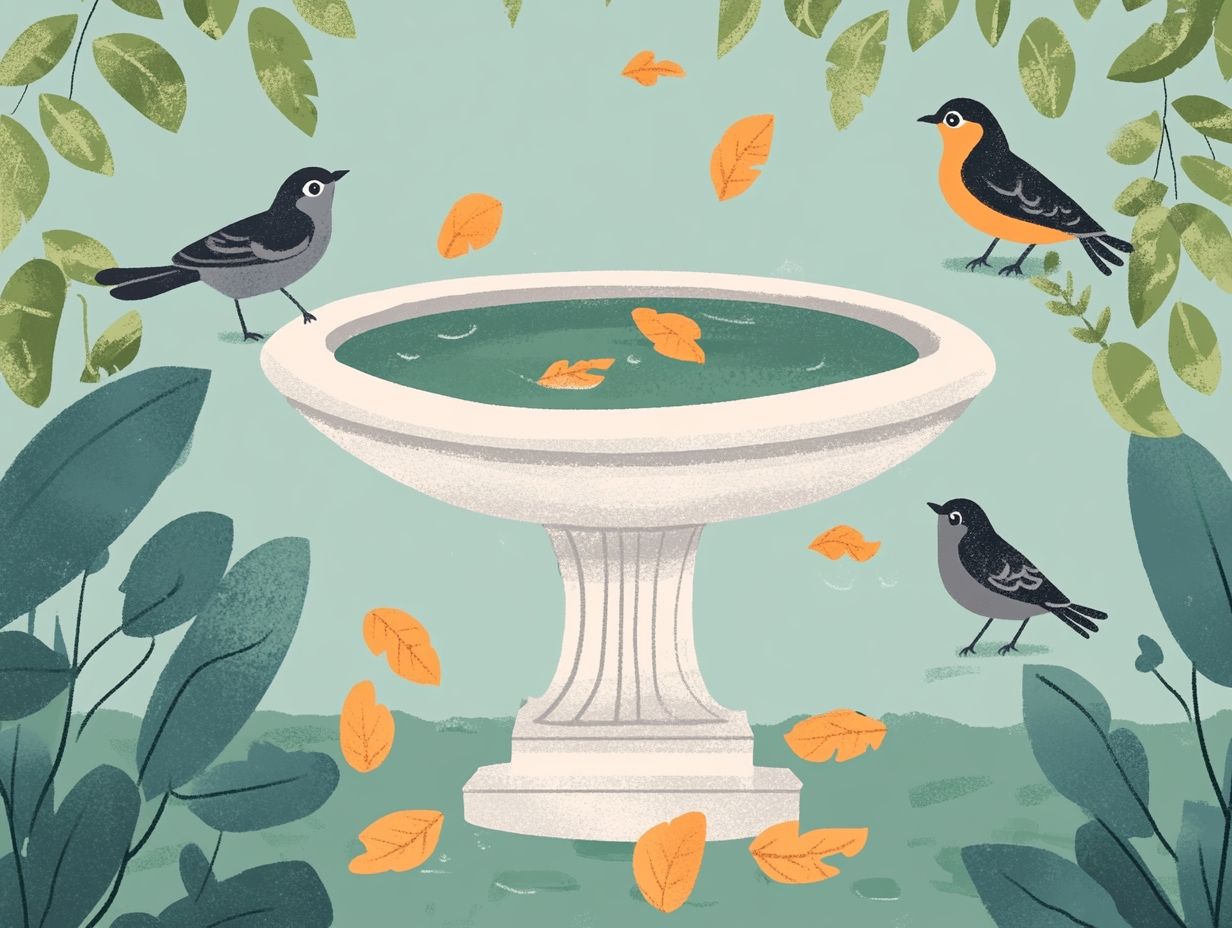
- Keep your bird bath clean to attract and protect birds!
- Avoid using soap or detergent to clean a bird bath as it can be harmful to birds and disrupt the natural balance of the water source.
- Placing a bird bath in direct sunlight can cause the water to become too hot and lead to algae growth, potentially harming birds.
1. Not Cleaning the Bird Bath Regularly
Regular maintenance of your bird bath is essential for drawing in a variety of bird species and keeping the birdbath depth appropriate for them. A clean water source not only promotes their health but also encourages frequent visits, especially during migration seasons when they desperately seek reliable fresh water and a safe habitat.
If you neglect cleaning, you might find algae taking over and the water quality declining. Both of these issues can deter birds and diminish your birdwatching enjoyment in the garden.
Establishing a consistent cleaning routine, ideally every few days, can significantly enhance the appeal of your bird bath. Simple methods, such as scrubbing the bath with a brush and using a vinegar and water mixture, can effectively banish harmful bacteria and dirt.
It’s vital to change the water regularly to keep it fresh; stale water can harbor diseases, posing health risks for visiting birds.
In the end, maintaining a clean bird bath not only attracts feathered visitors but also supports their well-being, transforming your backyard into a lively and vibrant sanctuary for all types of wildlife.
2. Using Soap or Detergent to Clean the Bird Bath
Using soap or detergent to clean your bird bath might seem convenient, but it can actually be quite harmful. These substances often leave behind residues that could jeopardize the health of the birds and discourage them from visiting your cherished water source, particularly during summer months.
Such residues can disrupt the natural oils on the birds’ feathers, making it tough for them to maintain their waterproofing and insulation. Harsh chemicals can be toxic if birds ingest them while drinking or bathing, leading to serious health issues or even fatalities.
To create a safe and welcoming environment for your feathered companions, consider opting for natural sources like white vinegar or baking soda mixed with water. These ingredients are not only effective for removing grime, but also safe for birds, helping you cultivate a thriving habitat where they can gather and flourish.
3. Placing the Bird Bath in Direct Sunlight
Placing your bird bath in direct sunlight can lead to rapid evaporation and water that s too warm for feathered friends, making it far less enticing. This is especially true during hot summer days when they crave refreshing, cool water sources.
By positioning your bird bath in a shady spot, you can maintain a more stable and inviting water temperature, which is essential for attracting your avian visitors.
This cooler environment not only keeps the water fresh for longer but also creates a more comfortable drinking spot for a variety of bird species. Birds are much more likely to visit a shaded bird bath during the sweltering heat as they hunt for hydration and relief.
Benefiting from the water movement created by a fountain, the dappled light can enhance the aesthetic charm of the bath, inviting more birds to explore while offering them a much-needed respite from the sun and creating perfect perching spots.
Get started today by placing your bird bath in the perfect spot and watch your garden thrive with life!
4. Not Providing Fresh Water Frequently
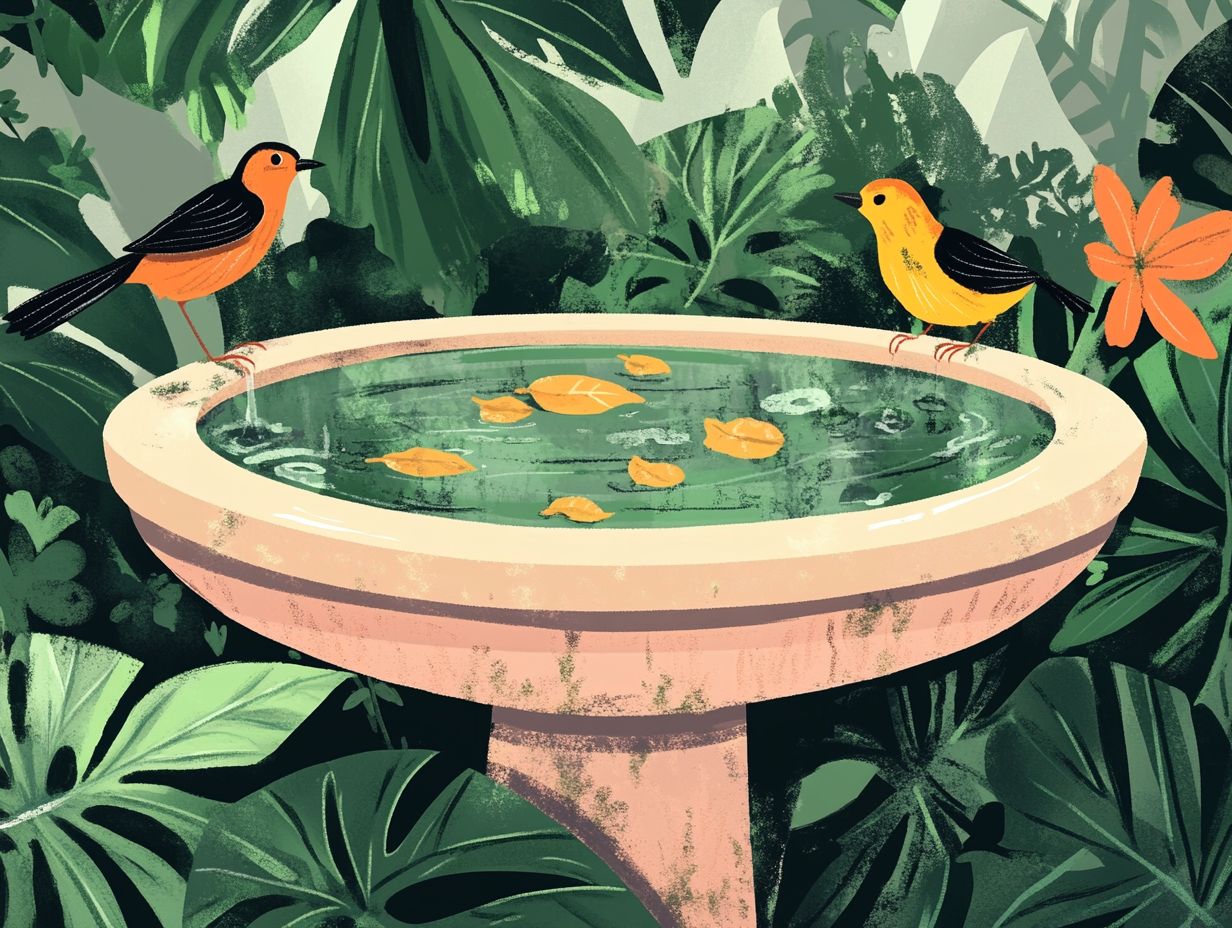
Failing to provide fresh water regularly is a significant oversight when it comes to bird bath usage and maintaining temperature. To enhance your garden and support local wildlife, consider exploring stylish bird baths that birds depend on for consistent daily refills to stay hydrated and safe in their environment.
Stagnant water not only lacks essential nutrients but can also become a breeding ground for harmful bacteria and mosquito larvae. This poses health risks to your feathered visitors and disrupts their habitat.
Establish a simple watering routine. Act now to ensure a fresh water source for your feathered friends by changing the water every other day. Consider adding a few stones to help circulate and aerate the water.
Place the bath in a shady spot to reduce algal growth, and adding a bird bath heater can attract even more birds, making your backyard a bird paradise!
5. Not Providing a Source of Shelter Nearby
Failing to provide a nearby source of shelter can deter birds from using your bird bath. They need safety from predators and a cozy environment to thrive.
Incorporate shrubs and trees close to your bird bath. This transforms the area into a sanctuary that beckons various avian species to take refuge and provides ample bird bath decor.
These natural elements create a protective canopy and offer perches for birds to rest and preen before or after a refreshing dip. This enhances your birdwatching experience.
The lush greenery improves the overall aesthetic of your outdoor space while encouraging a diverse array of bird activity, enriching the experience for those who enjoy observing them. When birds feel secure amidst the green plants, they are much more likely to embrace your bird bath as a cherished part of their daily routine.
How Can These Mistakes Affect Birds?
Mistakes in maintaining your bird bath can greatly impact bird species, compromising their access to clean water and safe habitats. To avoid these pitfalls, consider learning about the top bird photography mistakes to avoid. This neglect can lead to fewer visits and ultimately affect local wildlife populations that depend on these vital resources.
When water stagnates or becomes contaminated, it can turn into a breeding ground for harmful bacteria and parasites. This poses serious health risks for the birds that rely on the bath for drinking and bathing.
Species like robins and finches, celebrated for their vibrant plumage and cheerful songs, may shy away from areas with untidy baths. This results in fewer sightings and disruptions in their reproductive cycles, affecting local wildlife populations.
Failing to keep the bath free of debris could deter smaller birds such as sparrows and chickadees. These birds favor clean and safe environments and require adequate maintenance.
By fostering a welcoming space, you support avian health and enrich your experience by attracting a diverse array of wildlife to your garden.
What Are the Best Ways to Clean a Bird Bath?
The best approach to maintaining a bird bath is to establish a regular cleaning routine that embraces bird-friendly and eco-friendly practices. This ensures the water remains clean, safe, and inviting for your feathered visitors while minimizing environmental impact.
Incorporate effective cleaning techniques like using a simple solution of vinegar and water or baking soda to remove algae (which can make the water dirty) and grime without introducing harmful chemicals. Ensure bird bath safety by cleaning it every few days, especially during warmer months when algae tends to thrive.
Regularly inspect the water quality. Topping it off with fresh water as needed demonstrates attentive maintenance and ensures daily refills. To further enhance safety for the birds, position the bath in a shady area to reduce algae growth.
Always rinse it thoroughly before refilling to remove any residual cleaning solutions. This is crucial during winter watering.
What Are the Benefits of Placing a Bird Bath in Shade?
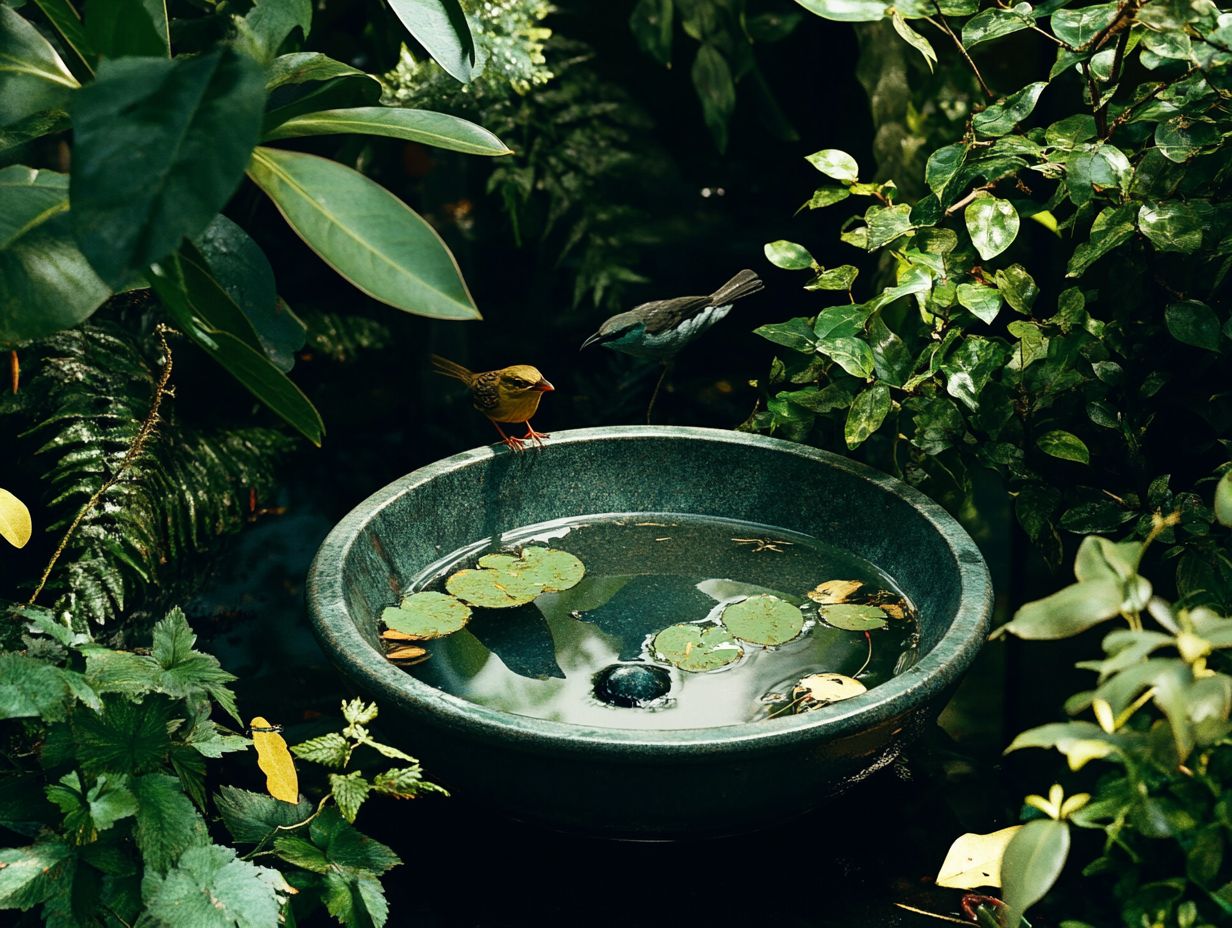
Placing a bird bath in the shade offers a wealth of benefits, such as maintaining cooler water temperatures and creating a welcoming environment that invites more feathered visitors during hot summer days.
The shaded area helps improve water quality by preventing green plant-like growth, which tends to flourish under direct sunlight. This means your bird bath remains fresh and clean for your avian friends.
Keeping the water cool also significantly reduces evaporation rates, ensuring a consistent supply throughout the day.
This natural oasis will attract a variety of bird species like robins, sparrows, and finches, all of which favor the gentle cover of trees or shrubs to enjoy their baths. Such a setting not only serves as a refreshing spot for birds but also makes birdwatching fun and exciting!
You’ll have the chance to observe these vibrant creatures flitting playfully amidst the greenery, enriching your outdoor decor.
How Often Should the Water in a Bird Bath Be Changed?
To ensure optimal water quality and effectively attract birds, you should change the water in your bird bath at least every couple of days, with daily refills being ideal during peak usage times, especially in summer.
Keep in mind that factors such as temperature, humidity, and seasonal changes can significantly affect how quickly the water gets dirty or evaporates. In hotter months, you might need to change the water more frequently, as birds flock to the bath for hydration.
In cooler seasons, you might not need to change the water often, but check it regularly for cleanliness.
To maintain a consistent refilling schedule, consider setting a specific time each day to refresh the water. Setting a specific time to refresh the water can attract more birds!
What Are Some Natural Sources of Shelter for Birds?
Creating natural shelter for birds in your outdoor space is about weaving together a delightful mix of shrubs and trees that serve as safe perches and protective hideaways. This approach fosters a welcome habitat for your feathered friends.
Consider incorporating native plants like dogwoods, willows, and elderberries. These varieties attract diverse bird species, each with their own unique needs and behaviors.
These plants provide nourishing berries and seeds, while also creating layers of foliage for birds to evade predators.
Arranging these plants in clusters enhances the visual appeal of your garden and offers shy species a sense of security, captivating birdwatchers in the process.
For example, cardinals are particularly drawn to dense shrubs for nesting, while finches flock to areas rich in seeds. By thoughtfully selecting plants that support local wildlife, you contribute to ecological balance and enhance biodiversity.
How Can One Attract More Birds to Their Bird Bath?
Attracting more birds to your bird bath is a delightful endeavor that can be elevated by enhancing its features and decor. Consider incorporating water movement and selecting designs that are visually appealing to draw in various bird species.
Adding a bird bath heater is a thoughtful touch, ensuring that fresh water remains available even during chilly winter months. This encourages birds to visit, even when other water sources are frozen!
To cultivate a welcoming atmosphere, think about surrounding the bird bath with native plants and natural elements like stones or logs. These additions not only provide shelter but also enrich the aesthetic charm of the area.
Installing bird feeders nearby with the right seed types can create a captivating focal point, attracting not just birds but a diverse array of wildlife, fostering a vibrant ecosystem right in your backyard.
Start enhancing your bird bath today and watch the birds flock to your yard!
Frequently Asked Questions
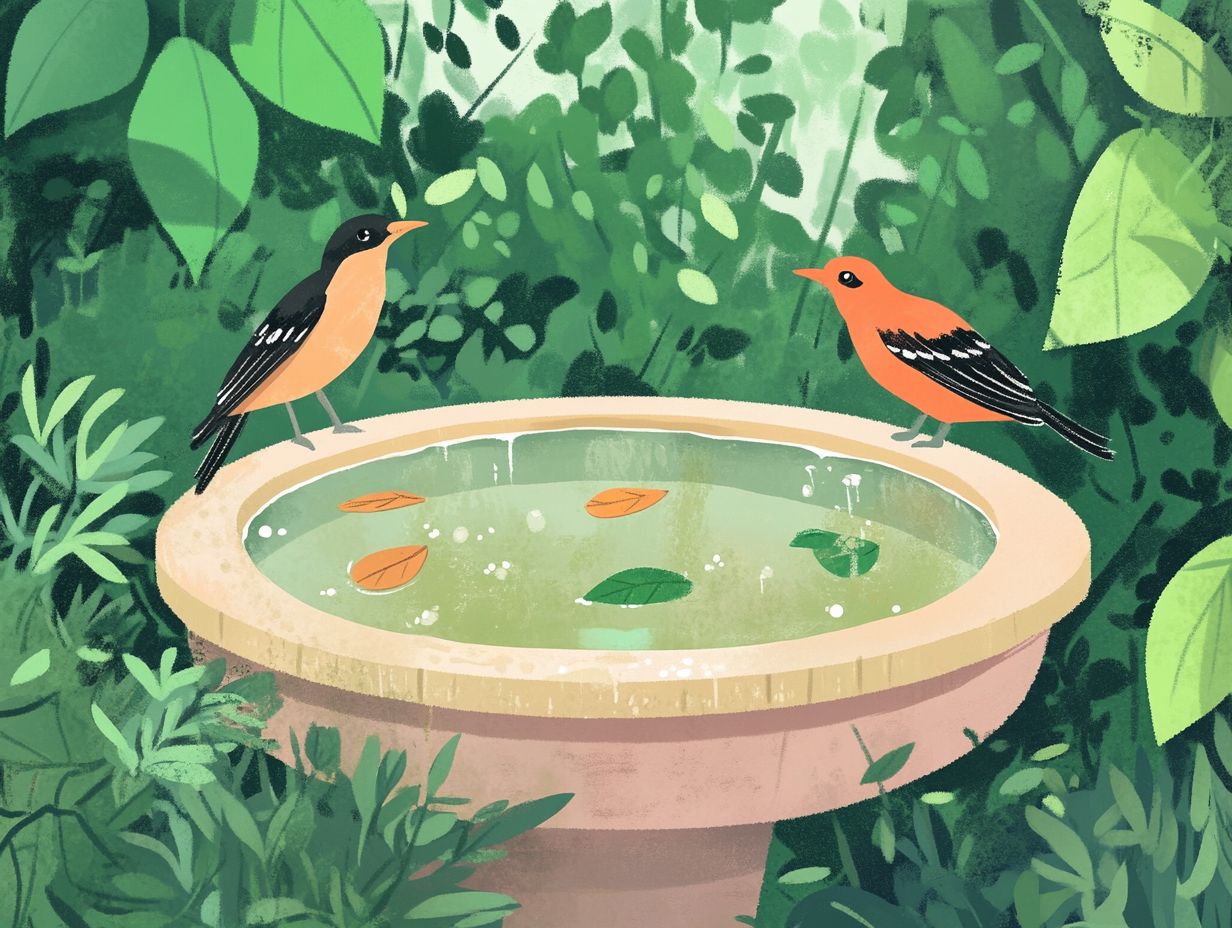
What are the 5 most common bird bath mistakes?
The 5 most common mistakes are not cleaning the bird bath enough, using harsh chemicals, and failing to provide shade. To avoid these pitfalls, consider following these 5 quick tips for bird bath maintenance.
Other mistakes include not adding water often and placing the bath in unsafe areas.
Why is regular cleaning important?
Regular cleaning prevents bacteria and diseases that can harm birds.
It also keeps the water fresh and inviting.
Can I use any cleaning products?
Avoid harsh chemicals like bleach or soap.
These can harm birds. Use mild soap or a vinegar and water mix instead.
How often should I add water?
Add water every other day to keep it fresh for the birds.
In hot weather, you might need to do this more often.
Why provide shade for birds?
Birds can easily overheat in the sun.
Providing shade, such as under a tree or with an umbrella, helps keep them cool.
Where should I avoid placing my bird bath?
Avoid areas near dangerous animals like cats.
It’s also best to keep the bath away from busy spots where people might scare the birds.

